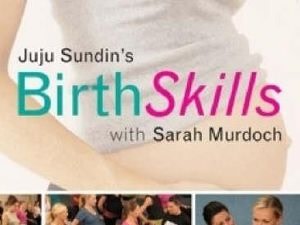Book Review: Juju Sundin's Birth Skills with Sarah Murdoch
05 Dec, 2021I was talking to a friend a few months ago about her labour and techniques she used to cope with the pain having birthed two children without an epidural, just gas and air, and she recommended Juju Sundin’s Birth Skills to me. I’d already read a number of books on hypnobirthing and gentle birth and I am currently listening to a hypnobirthing podcast so I just thought it would be more of the same but I added it to my list regardless.
As soon as I started reading Birth Skills, I knew that this was different. Stomping your feet in the shower and banging stress balls together and blowing flowers in a sink full of water – what?! This was completely different to anything I had read before to the point that I was a little in disbelief like is this a joke. But the more I read the book the more I could understand how using your body and having more active techniques to manage the pain physiologically made sense. It makes sense that not everyone can just breathe out a baby and ‘trust your body to instinctively know what to do’ as we hear many gentle birthing advocates say. Of course some do but we have evolved to be very intellectual creatures who get in our heads a lot and so what happens when you don’t instinctively know what to do and the gentle birthing techniques you have practiced aren’t enough to cope with the pain? Most of you are probably thinking – yell for an epidural – and whilst that is an option, another option is to try some active pain management techniques.
In her book Birth Skills, Juju Sundin explains how your body works in labour and why, how to turn fear into positive action so you can stay in control, how to use movement, breathing, vocalisation, visualisation, keywords and other handy techniques, what to wear, what to take, and what questions to ask, how your partner can help working with you as a team, and other women’s experiences using Juju’s techniques. It is helpful that she breaks down the techniques by each stage of labour. That is skills for the first stage of labour like movement, breathing and vocalisation, visualisation, stress balls and key words; and skills for the second stage of labour – pushing and crowning.
I personally never would have thought about using movement in my legs to distract myself from the pain in my uterus but it does make sense. Coupling movements with breathing, vocalisations, visualisations gives you a great toolkit to use along with your more gentle birth techniques like affirmations, music, smells, quotes on the wall etc. The key is to create a movement that is bigger than the pain – enough to overcome to the pain but not so big that you tire yourself out early with unnecessary exercise and activity and don’t have the stamina for the entire labour. Simple movements like banging stress balls together and vocalising ‘Pain out’ or ‘Healthy pain’ as you imagine the healthy pain radiating out of your body as your baby’s head descends and their body rotates to get into position for labour can be enough to help you cope with the pain. She also describes other techniques like your partner talking you through a visualisation – perhaps a walk on your local beach, as you imagine walking down the boardwalk, the feel of the water, the smell of the sand, as the tide goes out with each contraction and your pain with it.
Outside of the concept that labour can be so active physically, the other part of her book that I found most useful was in the Practice and Preparation section. I had no idea that a posterior labour could be so much more painful than anterior labour. For context, usually a baby will be in an anterior position with their head facing your bottom (face to back) position as they descend out of you, this is the perfect position for there head to curve through the cervix and fit through your pelvic diameter. Alternatively your baby might be in a posterior position with their face facing out towards your vagina (back to back). This may result in the baby’s head putting pressure on your sacrum and tailbone (the pointy bits of the pelvic diameter). According to Juju most babies will turn – only about 6% do not – you just have to give them time and try to get into positions that are optimal for encouraging them to turn. While if you had an anterior position for birth you might want to use positions to encourage gravity like squatting, bouncing on a birth ball, etc, with a posterior position this could actually make it worse and more complicated so its best to get on all fours, or lean over the bed rather than getting in a gravity friendly position. Juju provides some helpful tips for figuring out if it posterior or anterior birth before the midwife gets there/ you go to the hospital.
Juju also has a session for Partners which was touched on a bit lightly in the book but she did have sections in each skill chapter describing what a partner’s role would be to assist the labouring person in using each of the skills. I do think a lot of people underestimate the importance of the birth partner being completely aligned and in sync with the birthing person so that they operate as a team. Whilst the birthing person is labouring physically, their partner is working with them mentally to count in contractions, guide the visualisation stories, press a hot compress on their back, chant with them, guide them in using their stress balls and motivate them through the pain. Juju does a great job at emphasising the role of the birth partner in this book.
All in all this is a great book to read to ensure that you are prepared as best as possible with a diverse range of skills that you can use during birth. It may be that you don’t need such active skills and you can rely on gentle hypnobirthing type skills, it may be that you have a failure of labour to progress, or your baby is in distress, or the pain is getting unmanageable and you ask for medical interventions such as an epidural, a signal block epidural, gas and air, or there is a need for an emergency c-section. But preparation and practice will give you the best opportunity to have the birth that you want in the circumstances that you are in.
I also loved that even with the stories in the book that have ended in medical interventions or emergency c-sections the women were so grateful that they had been able to use their skills and have the experience of having the 12 hours of labour before the c-section rather than just going straight to a c-section. It is so reaffirming for me to hear these stories and see the value that experiencing childbirth and labour brings to women when they feel empowered and in control of the decisions they are making for themselves and their child every step of the way.
Get The Best Of Sleepy Roo Delivered To Your Inbox
Subscribe to my newsletter and get the latest info on baby sleep! You can unsubscribe at any time.



